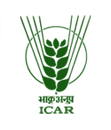All India Coordinated Research Project on Forage Crops and Utilization
IGFRI, Jhansi – 284003
The AICRP on Forage Crops, established in 1970, is a multi-disciplinary multi-location scheme envisaged for improvement in forages (arable rainfed and irrigated forage crops, range grasses and legumes) and generation of appropriate technology for boosting forage production in diverse agro-ecological regions of the country. The research is conducted through 22 Coordinated Centres (and Cooperating Testing locations) located all over country.
Rationale
The country has largely unorganized primitive subsidiary livestock production systems that do not allow scientific and technological interventions to permeate into them. Animal Husbandry continues to be a subsidiary appendage to crop production except peri-urban dairies and some organized dairies in private sectors. It is a livelihood source for nomadic and semi-nomadic tribes in arid and hill zone. Crop residues constitute the single largest bulk feed material alongwith several agro-industrial by-products such as vegetable and fruit processing residues and bagasse. Across ecosystems, dry matter availability through green is highest in the rainfed ecosystem, followed by irrigated and hill/mountain ecosystems.
Forage crop (intermediary inputs for livestock production) possesses certain unique problems, which is quite different from the food and horticultural crops. Besides multiplicity of the forage crop species and their nature, they are usually area, region and season specific. In most of the cases the degraded and marginal lands are usually allocated for forage production with minimum inputs in term of fertilizers, water and operational energy.
The regional and seasonal deficits are more important than the national deficit in case of forage as it is not economical to transport them over long distances. It appears that out of 55 micro-region of country; only 12 regions have surplus fodder, while the remaining 43 have deficits of some or the other kind.
To increase milk production from nearly 108 million tonnes at present to 160 million tonnes by 2020, the demands will be to the tune of 520, 850 and 90 million tonnes in respect of dry fodder, green fodder and concentrates. There is a wide gap in demand and supply for feed concentrates looking to the actual requirement of livestock.
There is a wide gap in demand and supply for feed concentrates looking to the actual requirement of livestock. It is because of low demands from livestock owners as they mostly feed homemade concentrate mixtures. There is a lack of awareness among the livestock owners regarding balanced feeding and nutrition.
Efforts are needed to strengthen fodder genetic resource base, and research on varietal improvement in forage crops (such as oats, sorghum, cowpea, pearl millet, maize, cowpea, berseem and Lucerne), range grasses and legumes for abiotic and biotic stresses, and appropriate forage production technologies for different farming systems in a range of agro-ecological regions. The technology for quality seed production is yet to be developed, especially in case of forage species for rainfed arable lands, rangelands and degraded lands. These aspects would be the focus of research on arable forage crops and range species in the XII Five Year Plan. This will help in improving the availability of quality forage for the livestock and quality seed and forage production technology for improved forage cultivation to achieve the socio-economic and ecological needs of the country.
Strategy
- Evolving short duration nutritious fodder varieties to fit in food fodder cropping systems.
- Forage varieties tolerant to abiotic stresses (saline, alkaline and drought situation) for better adoption of forage production technology.
- Fodder varieties will high yield and better quality.
- Forage based cropping system under irrigated condition-For improving balanced nutrition inclusion of perennial legumes.
- Design of Grassland and pasture management /silvi- horti pastoral systems for various regions in the country as per clientele need to integrate fodder production with other agro activities.
Mandate
- To coordinate multi-location testing programme at the national level with a view to identify appropriate varieties and production technologies for different agro-ecological conditions.
- To coordinate and monitor research related to problems of national and regional importance.
- To conduct strategic and applied research for boosting production and productivity of forages (arable, rainfed and irrigated forage crops, range grasses and legumes).
- To function as a major service centre for exchange of scientific information and research materials related to forages.
Objectives
- Exploration, collection and conservation of germplasm of forage crops and range species.
- Development of improved varieties / hybrids of forage crops and range species for increased livestock production.
- Development of region specific appropriate forage production and protection technologies and forage utilization through multidisciplinary approach for different cropping systems, rangelands and problem soils.
- Development of appropriate technology for seed production of forages.
- Transfer of technology.
- Scope of popularizing and research on non-conventional underutilized fodder crops/trees.
Major Research Programmes
- Exploration, collection, creation of variability through biotechnological means and other pre-breeding activities with aim to broaden genetic base in forage species.
- Development of varieties of key forage crops and also species having potential for multi-cut, and dual purpose types with acceptable quality.
- Development of appropriate forage production and protection technologies in system perspective for intensive agriculture and intercropping systems.
- Forage crop popularization through HRD and field demonstrations in different agro-climatic regions.
- Provide back up for quality forage seed availability through production of nucleus and breeder seed.


